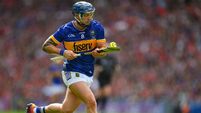‘No prehab could have saved Gooch from injury’

Waterford-based O’Sullivan, who has successfully performed two ACL surgeries on Henry Shefflin among several other GAA inter-county players such as Colm O’Neill, likened the manner in which the Kerry captain sustained his knee problem to how the Kilkenny star picked up his second cruciate rupture.
It’s since been revealed Cooper’s woes have been compounded by a fractured knee, which will be operated on in Santry tomorrow.
The 30-year-old was crippled with pain after falling in the process of scoring a first-half point for Dr Crokes in Portlaoise while being tackled by two Castlebar Mitchels players.
O’Sullivan encourages the GAA’s new prehab programme to prevent such injuries, but insists Cooper’s cruciate would have been damaged regardless.
“The Gooch there the last day, didn’t it look very simple? How many times has a fella given him a push in the back like that and he’s got up? Thousands and thousands of times.
“But on this occasion he just did it at the wrong angle with his toe and foot getting caught.
“Your brain automatically sets your muscles and everything to protect your knee, but if you get distracted by something else then that’s the moment that something happens.
“The last time Henry did it it was catching a ball against Cork. He had put up his hand and the ball just popped out of it. As he was landing, he tried to catch it a second time. His brainpower was concentrated on directing his hand to re-catch the ball instead of his knee to protect it. It’s always good to do exercises but it’s like saying you’ll never play hurling without breaking your finger — it doesn’t happen. If you turn 10,000 times there is a chance you will do your cruciate. All those things are certainly a help but there will always be cruciate injuries.”
O’Sullivan explains Cooper’s lengthy time out is more to do with bringing the anatomical hamstring graph, which will likely be used to replace his cruciate, back to life.
“The problem is in the first 10 to 12 weeks the graph is at its weakest because it is dying. For the next 12 weeks to six months it becomes revascularised and a living ligament again. That’s why there’s a wait.
“I had a fella in earlier in the week who had it done 12 weeks ago and he’s won three point-to-points in the last two or three weeks.
“He shouldn’t have been doing that. It’s not so much that the knee doesn’t feel right; it’s that the ligament isn’t strong enough. It hasn’t become biologically living tissue. Before the six months I feel they shouldn’t be doing too much running but then they can start running in straight lines and then at eight months there’s about a 95% success rate because the ligament is quite strong again.”
O’Sullivan, who can remember operating on Graham Canty’s cruciate back in the mid-1990s, has operated on Cork footballer O’Neill on three occasions but stresses the latter is the exception to the rule.
He debunks as a myth the idea cruciate surgery ages the knee, pointing out the surgery re-stabilises the joint, providing the correct protocols of recovery are followed.
“Gooch, before Saturday, had a perfect ligament. No matter how good your cruciate is, if you turn badly you can tear an old one as much as you can tear a new one. It’s amazing how few re-rupture relative to the stress and strain guys put back on them again. Henry has had two of them done and after them won All-Irelands. Iarla Tannian — another — was brilliant at centre-back for Galway last weekend.”
An under-age Cork hurler in his time, Schull-born O’Sullivan is irked when he hears how modern day players’ cruciates are regarded as weak compared to those of yesteryear.
“When I was playing, we trained maybe six weeks before a match and whether the games were with the club or Cork they were knockout. So 50% of the players were out of the competition with each game.
“Nowadays, an inter-county hurler playing the amount of games and training like he is has nearly as much incidence of twisting and turning on his knee than a player 20 years ago would have in 10 years of playing.
“He has 100 times more turning and twisting incidences than those players of years ago.”
The high quality of boots has conversely contributed to cruciate injuries too, he states. “Our grips now are better. You can’t play at the highest level if you slip. Your corner back is no good to you if he has bad boots. Nowadays, if you turn and your boot gives way it saves your cruciate but your guy runs in and scores a goal.
“We have better boots than ever before. The game is quicker and you have to turn faster. You need to have three or four different types of boots for the different surfaces. The reason for that is you don’t want to fall on your arse when the corner forward is trying to run around you!”














